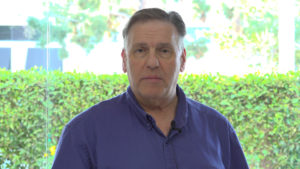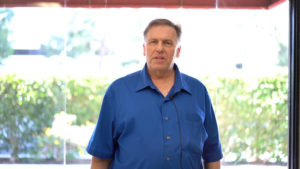Early this year, we did AF-C Face/Eye Tracking focus tests on four cameras: the Sony a9, the Panasonic GH5
, the Sony HXR NX80
, and the Canon XF405
. These tests are available to watch on our video podcast Tech Down Over, available below.
In these videos, we performed similar tests with each camera. Rick moved around while being filmed and face-tracked by each camera in different conditions: indoor lighting, direct sunlight, and outdoor shade, and at different distances and zoom levels.
As an eLearning and training development company, many of the videos we make are "run-and-gun," meaning we shoot many of the interviews and other videos we make for customers on site. Therefore, this series of tests was performed in a manner that simulates this type of shooting with little-to-no time to prepare, by moving from area to area without the stops to adjust and configure cameras and equipment that are possible in a studio setting.
Although these are focus tests, we also noticed significant differences in how the cameras handled contrast; that is, whether they were able to maintain contast in the face when the background or other elements were much brighter or higher-contrast than the subject.
Focus Test Videos:
(Analysis and comparison below)
Sony a9
Panasonic GH5
Sony HXR NX80
Canon XF405
Test Results:
Focus: Distance Test
Both Sony cameras held clear focus even when Rick was outdoors in daylight and very small in the frame. See 3:10 in the a9 video and 2:25 in the NX80 video, compared to 3:35 in the GH5 video and 6:15 in the XF405 video. At these points, the GH5 and Canon XF405's focus reticles stopped following Rick, but the Sony a9 and NX80's focus reticles stayed locked on Rick's eyes.
Focus: Detection Area Edge Test
The ability to keep a moving subject in focus is essential to dynamic scenes and action videography. Based on our tests, we found that the Sony a9 kept focus in the largest area of its frame, which was effectively the whole frame, as far as we could tell (see test at 4:27) compared to the other cameras. The Sony NX80 came in second, though its focus area was noticeably smaller than that of the a9 (see 3:15).
The Canon XF405 and the Panasonic GH5 had similar-sized focus areas, smaller than both the Sony cameras (see 5:07 for the XF405 and 2:40 for the GH5).
Focus: Distraction and Subject Obstruction
To give context to this test, last year (2017), the Panasonic GH5's autofocus was commonly criticized in the photography community for being easily distracted and losing focus when obstructions passed in front of the subject.
In response, Panasonic released Firmware Ver. 2 for the GH5 in September 2017, intended to fix the issues that photographers were experiencing with "wobbly" autofocus that would cause the focal plane to see-saw back and forth, sometimes for several seconds before settling on the subject.
Our tests seemed to mostly bear this out—at 5:20 in the GH5 footage, Rick tests this by waving his hands in front of his face. The GH5's autofocus is slightly distracted when the open hand first comes into frame, and when the hands actually cross over Rick's face, but holds focus the rest of the time Rick is waving around his hands, which is a big improvement on our previous experiences with the GH5's autofocus.
Still, The Sony NX80 (5:40) and the Canon XF405 (8:20) both did a better job on this test, or about equivalent to each other. Neither lost focus at all during this test. Note that we didn't do this particular exercise when testing the a9.
We noticed that the XF405's focus reticle stuck to Rick's head even several seconds after his hands totally blocked his face, and when he turned so that only the back of his head was visible. However, this didn't necessarily translate to better focus than the Sony NX80. Even though its focus reticles disappeared soon after Rick blocked his face or turned around, the NX80 near-instantly reacquired focus (thanks to Sony's ridiculously quick Hybrid AF) whereas, whenever the XF405 lost focus, it took 1-2 seconds to reacquire.
Contrast and Vibrance
Following are stills of our backlit-subject contrast test. These are unaltered except for scaling.
Sony NX80

Panasonic GH5

Canon XF405

Sony a9

To us, the Sony a9 shot is striking in its contrast, detail, and color vibrance despite being so strongly backlit. The NX80 and XF405 are roughly comparable, with the GH5 somewhat lagging in this test. Of course, this type of shot is not typically seen in professional photography and videography, often considered an amateur mistake, but if the a9 is any indication of the future state of cameras, such a shot may become more feasible as a stylistic choice.
Also, this sort of shot is likely to occur in many "point-and-shoot" situations, such as when filming children's sports games, outdoor weddings, family outings, etc.
Conclusion
Focus: Distance Test
Out of the four cameras we tested, we declare the Sony a9 as the winner in this comparison. However, it's also the most expensive by far, at about $4,500.00 USD for the camera body alone. For a professional action photography and videography or cinematography, this is a very viable choice, but most other photographers and videographers would probably opt for something more affordable.
Out of the other three cameras, the Panasonic GH5 is a good all-around choice, offering excellent features for both photos and video at about $2,000 USD (body only).
For video only, we recommend the Sony NX80 over the Canon XF405. The NX80 and XF405 aren't strictly equivalent, as the NX80 is HDMI-only, and the XF405 has an SDI interface, but at about $2,300 USD, the NX80 is much cheaper than the HDMI-only XF400, which is $3,000 USD (the SDI-enabled Sony PXW-Z90 and Canon XF405 are about $2,800 and $3,500, respectively).
No comments:
Post a Comment